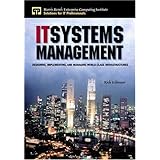
Average Reviews:

(More customer reviews)I did not really learn anything new from the 500 page "IT Systems Management", but Schiesser created an ITIL-like framework from which I can logically organize and reflect on my past experiences and better understand my future experiences.
Schiesser starts by giving a brief but comprehensive history of computing and systems management. In Part 2, he presents a discussion on "people", organizational, and political issues which would be valuable for any new IT manager, although less so for experienced ones. Finally, on page 109, in part 3, "Processes", he finally begins the meat of the book.
Schiesser defines systems management as twelve processes: Availability, Performance and Tuning, Production Acceptance, Change Management, Problem Management, Storage Management, Network Management, Configuration Management, Capacity Planning, Strategic Security, Disaster Recovery, and Facilities Management.
He discusses each of the above areas, devoting a chapter for each. Some chapters provide more insight than others. Most of the points are obvious for a weathered IT manager, but it does provide value in compiling all the obvious points in one place. And, as mentioned earlier, it provides a framework for thought about managing a data center and or an enterprise.
Schiesser uses a lot of paper with lists of things: characteristics of process owners, resources to consider, steps to developing..., issues, challenges, etc., etc. He also includes assessment worksheets for each process - in duplicate versions: one with weights and one without. That is within the text --- he lists them again in the appendix. I think over half the book is assessment worksheets ... and a lot of white space. If he was adamant about listing all of these worksheets, I think the reader would have been much more appreciative of an included CD so they could actually use them without hiring a typist.
Appendix A is a FAQ, which is an excellent idea to address random thoughts about each chapter, but it was much too short at ten pages. I would much rather have an expanded FAQ rather than hundreds of pages of assessments.
He concludes the book with Part 4 "Technology" - a title I thought was a misnomer. This part includes a chapter on "Developing Robust Processes", with sections like "Helpful Ground Rules for Brainstorming" and "Understanding the Differences between a Formal and Informal Process", which I thought were inappropriate for the subject of the book and too cursory to be of any use. This chapter is followed by another cursory presentation of technology to automate processes, a chapter discussing integration of the 12 processes, and finally special considerations for client-server and Internet computing.
"IT Systems Management" is a good *overview*. IT managers with a few years in the industry will appreciate the framework presented in the 200 pages of part 3, but should not expect any earth-shattering revelations or new insights. For a more detailed presentation of the subject, look into the ITIL books.
Click Here to see more reviews about: IT Systems Management: Designing, Implementing, and Managing World-Class Infrastructures
Product Description:
IT Systems Management explains the relatively new study of the theoretical and practical aspects of managing an organization's IT infrastructure. Focusing on the key areas of people, process, and technology, author Rich Schiesser shows how systems management techniques can streamline the IT infrastructure so that it is optimally stable, efficient, and responsive.
Want to read more honest consumer review about IT Systems Management: Designing, Implementing, and Managing World-Class Infrastructures now ?

0 comments:
Post a Comment